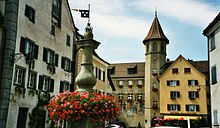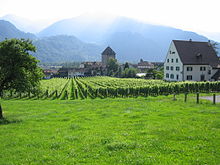Maienfeld
This is the sighted version that was marked on April 5, 2021. There is 1 pending change that needs to be sighted.
![]()
This article describes the municipality of Maienfeld in Switzerland; Maienfeld is also a district of the municipality of Waldthurn in Bavaria.
Maienfeld (Rhaeto-Romanic ![]() ) is a municipality with town charter in the Bündner Herrschaft region at the foot of the Falknis mountain. Maienfeld is surrounded by vineyards. Maienfeld is the place of arrival of the protagonist in Switzerland in the novel Heidi by Johanna Spyri. Politically, Maienfeld belongs to the Landquart region of the canton of Graubünden.
) is a municipality with town charter in the Bündner Herrschaft region at the foot of the Falknis mountain. Maienfeld is surrounded by vineyards. Maienfeld is the place of arrival of the protagonist in Switzerland in the novel Heidi by Johanna Spyri. Politically, Maienfeld belongs to the Landquart region of the canton of Graubünden.
History
Prehistoric finds have been made in the municipal area. Maienfeld is first mentioned in the 4th century as Magia on Peutinger's tablet, 801-805 as Lupinis. Magia was probably a Roman station on the historic roads in the Rhine Valley, at the fork of the road to Zurich (Turicum) and Bregenz (Brigantium).
The town charter was first documented in 1434, but market rights lay with Malans. Traditionally, Maienfeld is still called the town today, the central square being the "Städtli". Maienfeld had been a member of the Zehngerichtebund since 1436, and in 1438 it concluded a town charter with the Barons of Brandis. From 1416 to 1510, they were lords of Maienfeld, together with the County of Vaduz and the Lordship of Schellenberg in present-day Liechtenstein. In 1499, Maienfeld was occupied by the Confederates and the Swiss Confederates in the course of the Swabian War. In the process, the barons fell into captivity. In 1510, the Drei Bünde bought Maienfeld from the Barons of Brandis. This meant that the Maienfelders were, on the one hand, sovereigns as members of the Zehngerichtsbund, but on the other hand, subjects of the Drei Bünde, as Maienfeld was part of a "Gemeine Herrschaft" of the Drei Bünde called "Bündner Herrschaft". Since the dominions of Schellenberg and Vaduz were sold to the Counts of Sulz, today's national border between Liechtenstein and Switzerland was formed near the St. Luzisteig. Maienfeld became a border town. In 1803 it became part of Switzerland with the accession of the Three Confederations.
From the 14th century onwards, Walsers migrated to the area around the town and founded several settlements, which became part of the town as the Walsergemeinde Berg. Their inhabitants were not admitted to the town's citizenship until centuries later. These settlements include Rofels, Bovel, Guscha, Stürfis and Vatscherin ("Hölzli"), the latter two now deserted.
Maienfeld, until then Rhaeto-Romanic, was Germanised in the 16th century. The Reformation was introduced as early as 1529.
After the construction of the Rhine valley line from St. Gallen to Chur in the mid-19th century, shortly followed by a branch line to Zurich, the town lost importance for passenger and goods traffic. Its function as a regional centre passed to the nearby towns of Bad Ragaz, Sargans and Landquart.

Town hall of Maienfeld (right)

Brandis Castle
Coat of arms
Description: In blue three (2:1) set six-pointed golden stars.
Search within the encyclopedia